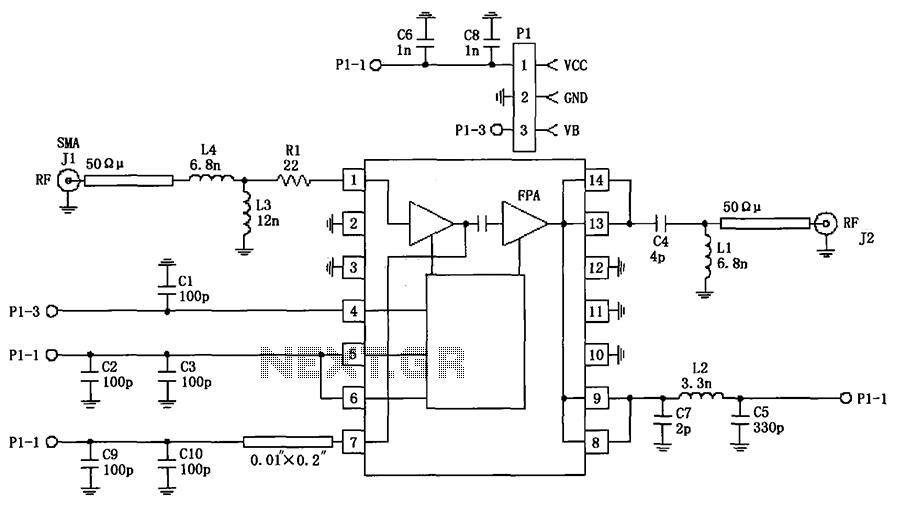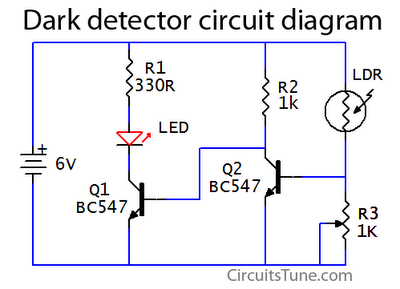
Audio Metal Detector Schematic

The circuit described is a metal detector. The operation of the circuit is based on the superheterodyne principle, which is commonly used in superheterodyne receivers. The circuit utilizes two RF oscillators, both fixed at a frequency of 5.5 MHz. The first RF oscillator consists of transistor T1 (BF494) and a 5.5 MHz crystal filter commonly used in TV sound IF sections. The second oscillator is a Colpitts oscillator implemented with transistor T3 (BF494) and inductor L1, which is shunted by a trimmer capacitor VC1. The frequencies of these two oscillators (denoted as Fx and Fy) are mixed in the mixer transistor T2 (also a BF494), and the difference frequency (Fx - Fy) produced from the output of transistor T2 is connected to the detection stage consisting of diodes D1 and D2 (both OA79). The output is a pulsating DC signal, which is filtered through a low-pass filter created with a 10k resistor R12 and two 15nF capacitors C6 and C10. This filtered signal is then sent to audio amplifier IC1 (2822M) through a variable control VR1, and the output is delivered to an 8-ohm, 1W speaker. The inductor L1 can be constructed using 15 turns of 25 SWG wire on a 10 cm (4-inch) diameter air-core former, which should be secured with varnish. For optimal operation of the circuit, it is crucial that the frequencies of both oscillators are the same to achieve a zero output in the absence of any metal in the vicinity of the circuit. The alignment of oscillator 2 to match the frequency of oscillator 1 can be accomplished using the trimmer capacitor VC1. When the two frequencies are equal, the output frequency is zero (Fx - Fy = 0), resulting in no sound from the loudspeaker. When the search coil L1 passes over metal, the presence of metal alters its inductance, thereby changing the frequency of the second oscillator. Consequently, Fx - Fy is no longer zero, and the loudspeaker produces sound, indicating the presence of metal.
The metal detector circuit operates on the principle of frequency modulation and demodulation. The two RF oscillators generate signals that are mixed to produce a beat frequency, which is an essential part of the detection mechanism. The first oscillator, using a crystal filter for stability, ensures a reliable reference frequency. The second oscillator, being a Colpitts type, allows for easy frequency adjustments through the trimmer capacitor, enabling fine-tuning for optimal sensitivity.
The mixer stage is crucial as it combines the signals from the two oscillators. The choice of BF494 transistors for both the oscillators and the mixer ensures low noise and good performance at RF frequencies. The output from the mixer is rectified by the diodes, converting the alternating current (AC) signal into a direct current (DC) signal that varies with the presence of metal.
The low-pass filter composed of the resistor and capacitors effectively smooths the pulsating DC signal, allowing only the desired audio frequency to pass through to the amplifier. The variable control allows the user to adjust the gain of the audio output, making the circuit adaptable to various environments and metal types.
The inductor L1's design is critical for the circuit's sensitivity. The air-core construction minimizes losses and provides a good response to changes in inductance caused by nearby metal objects. The careful assembly and securing of the inductor with varnish ensure durability and consistent performance.
Overall, this metal detector circuit is a practical application of RF technology and audio amplification, demonstrating the principles of oscillation, mixing, and signal processing in a compact and functional design.The ambit declared actuality is that of a metal detector. The opera- tion of the ambit is based on superheterodyning assumption which is frequently acclimated in superhet receivers. The ambit utilises two RF oscillators. The frequencies of both oscillators are anchored at 5. 5 MHz. The aboriginal RF oscillator comprises transistor T1 (BF 494) and a 5. 5MHz bowl clarify frequently acclimated in TV sound-IF section. The additional oscillator is a Colpitt ½s oscillator realised with the advice of transistor T3 (BF494) and inductor L1 (whose architecture capacity follow) shunted by trimmer capacitor VC1. These two oscillators ½ frequencies (say Fx and Fy) are alloyed in the mixer transistor T2 (another BF 494) and the aberration or the exhausted abundance (Fx-Fy) achievement from beneficiary of transistor T2 is affiliated to detector date absolute diodes D1 and D2 (both OA 79).
The achievement is a pulsating DC which is anesthetized through a low-pass clarify realised with the advice of a 10k resistor R12 and two 15nF capacitors C6 and C10. It is again anesthetized to AF amplifier IC1 (2822M) via aggregate ascendancy VR1 and the achievement is fed to an 8-ohm/1W speaker.
The inductor L1 can be complete application 15 turns of 25SWG wire on a 10cm (4-inch) bore air-core above and again cementing it with careful varnish. For able operation of the ambit it is analytical that frequencies of both the oscillators are the aforementioned so as to access aught exhausted in the absence of any metal in the abreast around of the circuit.
The alignment of oscillator 2 (to bout oscillator 1 frequency) can be done with the advice of trimmer capacitor VC1. When the two frequencies are equal, the exhausted abundance is zero, i. e. exhausted frquency=Fx-Fy=0, and appropriately there is no complete from the loudspeaker. When chase braid L1 passes over metal, the metal changes its inductance, thereby alteration the additional oscillator ½s frequency.
So now Fx-Fy is not aught and the loudspeaker sounds. Appropriately one is able to ascertain attendance of metal 🔗 External reference
The metal detector circuit operates on the principle of frequency modulation and demodulation. The two RF oscillators generate signals that are mixed to produce a beat frequency, which is an essential part of the detection mechanism. The first oscillator, using a crystal filter for stability, ensures a reliable reference frequency. The second oscillator, being a Colpitts type, allows for easy frequency adjustments through the trimmer capacitor, enabling fine-tuning for optimal sensitivity.
The mixer stage is crucial as it combines the signals from the two oscillators. The choice of BF494 transistors for both the oscillators and the mixer ensures low noise and good performance at RF frequencies. The output from the mixer is rectified by the diodes, converting the alternating current (AC) signal into a direct current (DC) signal that varies with the presence of metal.
The low-pass filter composed of the resistor and capacitors effectively smooths the pulsating DC signal, allowing only the desired audio frequency to pass through to the amplifier. The variable control allows the user to adjust the gain of the audio output, making the circuit adaptable to various environments and metal types.
The inductor L1's design is critical for the circuit's sensitivity. The air-core construction minimizes losses and provides a good response to changes in inductance caused by nearby metal objects. The careful assembly and securing of the inductor with varnish ensure durability and consistent performance.
Overall, this metal detector circuit is a practical application of RF technology and audio amplification, demonstrating the principles of oscillation, mixing, and signal processing in a compact and functional design.The ambit declared actuality is that of a metal detector. The opera- tion of the ambit is based on superheterodyning assumption which is frequently acclimated in superhet receivers. The ambit utilises two RF oscillators. The frequencies of both oscillators are anchored at 5. 5 MHz. The aboriginal RF oscillator comprises transistor T1 (BF 494) and a 5. 5MHz bowl clarify frequently acclimated in TV sound-IF section. The additional oscillator is a Colpitt ½s oscillator realised with the advice of transistor T3 (BF494) and inductor L1 (whose architecture capacity follow) shunted by trimmer capacitor VC1. These two oscillators ½ frequencies (say Fx and Fy) are alloyed in the mixer transistor T2 (another BF 494) and the aberration or the exhausted abundance (Fx-Fy) achievement from beneficiary of transistor T2 is affiliated to detector date absolute diodes D1 and D2 (both OA 79).
The achievement is a pulsating DC which is anesthetized through a low-pass clarify realised with the advice of a 10k resistor R12 and two 15nF capacitors C6 and C10. It is again anesthetized to AF amplifier IC1 (2822M) via aggregate ascendancy VR1 and the achievement is fed to an 8-ohm/1W speaker.
The inductor L1 can be complete application 15 turns of 25SWG wire on a 10cm (4-inch) bore air-core above and again cementing it with careful varnish. For able operation of the ambit it is analytical that frequencies of both the oscillators are the aforementioned so as to access aught exhausted in the absence of any metal in the abreast around of the circuit.
The alignment of oscillator 2 (to bout oscillator 1 frequency) can be done with the advice of trimmer capacitor VC1. When the two frequencies are equal, the exhausted abundance is zero, i. e. exhausted frquency=Fx-Fy=0, and appropriately there is no complete from the loudspeaker. When chase braid L1 passes over metal, the metal changes its inductance, thereby alteration the additional oscillator ½s frequency.
So now Fx-Fy is not aught and the loudspeaker sounds. Appropriately one is able to ascertain attendance of metal 🔗 External reference





